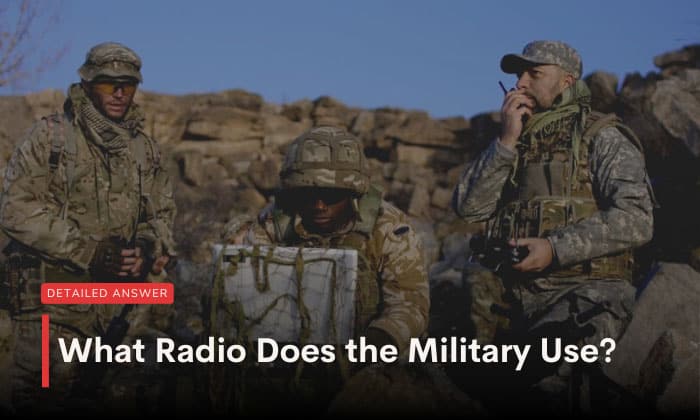
If you are a military enthusiast and know a thing or two about radios, you might be interested in, “What radio does the military use?”
To name a few notable examples, the military uses the Intra Team Radio, AN/PRC-162 Radio, Compact Team Radio, SINCGARS Radio, and many more.
In this blog post, we will give you a whole list! Besides the names, we will touch on the specifics of each. We will also have a section on other military communication devices and FAQs. Read on!
Table of Contents
List of US Military Radios
1. Thales AN/PRC-148D IMBITR from Thales Group
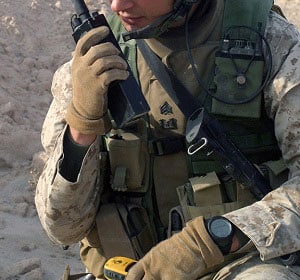
This is a handheld radio made to field the Army Warrior Robust Enhanced Network waveform, a type 1 scalable and strong tactical network with more than 800 nodes. The IMBITR can work in difficult radio frequency environments, such as caves and shipboards, too. In any case, its frequency range is from 30 MHz to 512 MHz.
This military is small, lightweight, and ruggedly housed to assist tactical operations. On the radio, you can find:
- Embedded commercial GPS
- Cutting-edge technology providing 2-channel functions simultaneously
- Narrowband capabilities and waveforms between 30 MHz and 512 MHz
- Wideband channel capabilities
2. AN/PRC-162 Radio from Collins Aerospace
This is a 2-channel ground radio with both wideband and narrowband. It lets the military simultaneously maintain interoperability with next-gen and legacy waveforms. It has various frequency ranges, such as 225-450 MHz, 764 – 941 MHz, 1250 – 1450 MHz, etc. If necessary, you can extend its range up to 2500 MHz.
Compared to older ground radios, the AN/PRC-162 is furnished with sounder battery life, power output, and signal sensitivity nature.
This radio also boasts noteworthy functionalities like high-speed mobile communications, next-gen SATCOM, point-to-point data, and in-theater IP waveform communications.
3. Compact Team Radio from L3Harris Technologies

This is a single-channel, modern military radio designed by L3Harris to support the military’s connected-network goal. It takes and shares voice and sensor data from all users to make sure the entire military network is always well-informed. This, in turn, improves combat effectiveness.
With a single battery, it can provide over 20 hours of continuously dependable communication. It is also small and light, easing use for operators. Teams using this radio can be connected at larger distances. This radio’s frequency range is between 225 – 2600 MHz.
The military ordered 1000 one these radios in 2021 and plans to replace these with their current SINCGARS Army radio systems.
4. SINCGARS Radio from L3Harris Technologies
SINCGARS is used by the military as a Combat-Net radio. SINCGARS radio setup includes three systems: SINCGARS, HF radio, and SC tactical satellite. In addition, this radio functions on 2320 channels between 30 MHz and 88 MHz
As a military tactical radio, the SINCGARS is designed to be vehicle-mountable, fit for the air, and backpack-tuckable. It is also available as a military handheld radio. As the SINCGARS frequency range can vary from 200 meters to 10 kilometers, it provides excellent communication between those on land and those in the air.
Thanks to the SINCGARS Army radio, the military can exchange information during joint and combined operations with a low probability of attack. There is also better situational awareness and more practical engagement as a result.
Over the years, there have been many SINCGARS serving the military radio communication systems, with the earliest one introduced in 1988 before being replaced by its successor, the RT1523, in 1990.
5. ASIP Army Radio
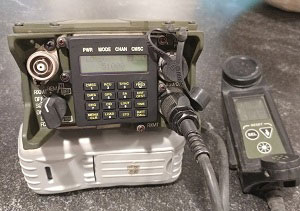
This is a manpack radio set to replace the military’s current SIP radios. The A in its name is short for Advanced. It is an adapted version of the SINCGARS airborne radio and will be utilized in the Army’s 1 and 2 Packages.
The ASIP radio is smaller and lighter, making it more user-friendly. In addition, it is fitted with newer technology, like a signal processing (digital) function. Its battery life is also improved thanks to lower-power automation.
6. Personal Network Radio (PNR-500) from Tadiran
This is a digital squad radio typically used by smaller military units on combat ships and in urban warfare. It has 15 channels and a frequency range of 400 MHz to 450 MHZ. For classification purposes, this Tadiran radio can fall under UHF radios.
The main notable features of the Personal Network Radio (PNR-500) are:
- Dynamic synchronization
- Hands-free operation
- Inter-connectivity to long-range radio networks
- Full-duplex conference for up to 6 users at a time and unlimited listeners
Some other special features that make it highly reliable include:
- A whisper function for security-stressing communication
- An internal GPS receiver
- An AED encryption function
- A transmission priority setting
- An emergency break-in setting
- An emergency broadcast setting
- A free frequency search module to tackle jammed settings
- A VA adapter and VA charger
- Max of 800 mW power output
The PNR-500 radio weighs less than 450 grams and is small-sized, making it easy to use, even in challenging military settings. Thanks to it, the military can make important operational decisions using real-time information, which eliminates errors and enhances coordination.
7. Motorola Military 2-Way Radio
The military uses three Motorola Army walkie talkies: the Motorola RMU-2040, RDU-4100, and RDU-4160D.
- Motorola RMU-2040: The most economical one out of the three. It operates on 5500 and 467.9250 MHz frequencies.
- Motorola RDU-4100: The most robust and durable one out of the three. Its frequency range is between 151 and 470 MHz.
- Motorola RDU-4160D: The most powerful one out of the three. This model has 16 different channels, all operating on a frequency range between 461-464 MHz.
These portable and wearable communication devices are preferred for offering encrypted, faster, and more reliable communication. In addition, it is durable enough for rugged military settings.
Some Other Military Communication Equipment
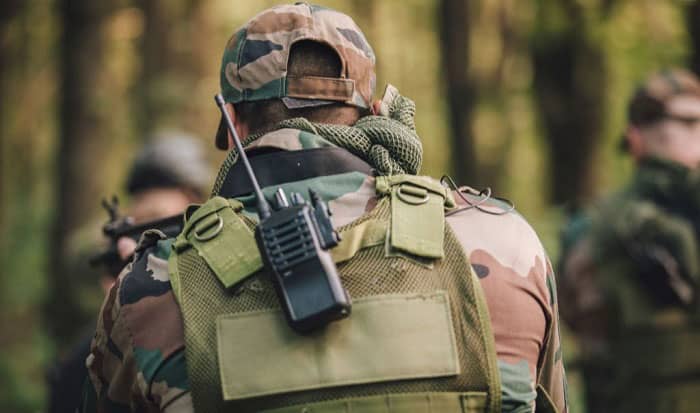
1. Wireless Digital Intercom
This equipment allows you to transmit voice communication wirelessly. The key benefit of this is taking cable hazards out of the picture. Other perks include a full duplex, hands-free, and multi-channel communication.
2. Satellite Communication System (SATCOM)
This refers to devices that bypass obstacles in short-range radio traffic and the Earth’s curvature to enable radios to communicate over intercontinental distances. SATCOM uses several ultra-high frequencies: C-, L-, Ka-, Ku-, S-, and X-bands.
Usually, it is used by dismounted troops and transportation, like warships, submarines, aircraft, and land vehicles. The system can also be found in bases and headquarters.
A complete setup includes satellites, a teleport, a ground station, and supporting infrastructures, such as a headquarters where the satellites are controlled.
3. Cryptography Machine
This is a tool that provides automatic encryption for secure communication. Using an algorithm, it changes an input like plain text into an encrypted output like cipher text.
Last year, the Army signed into a +700 million contract for new cryptology equipment that will take the place of its Simple Key Loader device. 265,000 pieces of equipment will be fielded in 2025 across the branches and supplied to foreign military partners as well.
The delivery is expected to permit network managers to:
- Reconfigure cryptographic results
- Download software remotely
- Enhance operational environment awareness
All of which optimize tactical, strategic, and enterprise performance in the military.
Frequently Asked Questions (FAQs)
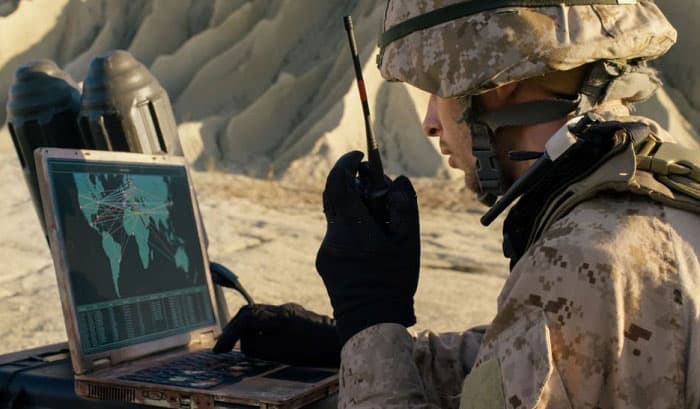
How did the military communicate in the past?
Before advanced technology, the military relied on traditional means, such as messengers, flags, hand & arm signaling, Morse codes, signal lamps, drums, horns, letters, heliographs, etc.
Military communication evolved from messengers to signals (visual and audible) to digital tools, devices, systems, etc.
What is the importance of radios in the military?
There are plenty of reasons why radios play a significant role in the military. Here are some of the main ones:
- Faster and more efficient communication, even in obscuring terrain
- Allow for communication from larger distances, including across nations
- Let many military members “hear in” at once
- Makes on-the-move communication possible
- Enable military members to communicate in a more covert and secure manner
Does the military use FM or AM radios?
A few military radios use single sideband (SSB), which can be considered a form of AM. Most of the radios used in the military, however, are FM. These provide flexible, quick, but still reliable communication. The SINCGARS radios mentioned above are a part of the FM radios family.
By now, you should be able to give comprehensive answers to the question, “What radio does the military use?” In addition, I hope you also remember other forms of communication used within the military, like wireless digital intercoms, satellite communication systems (SATCOM), and cryptography tools.
If you have any relevant thoughts or questions you’d like to ask, leave comments. We are always happy to hear from our readers.

I am Everett Bledsoe, taking on the responsibility of content producer for The Soldiers Project. My purpose in this project is to give honest reviews on the gear utilized and tested over time. Of course, you cannot go wrong when checking out our package of information and guide, too, as they come from reliable sources and years of experience.
